Abstract
In the World, the SARS Cov-2 Covid-19 pandemic has grown exponential with 3.99 million confirmed cases and 278,814 deaths as on May 10, 2020. Countries have implemented varying levels of containment and social distancing measures with mixed trends of success and effectiveness. Despite data driven early predictions of petering out of Covid-19 by May to Jun of 2020, the end is nowhere in sight, barring a few nations like China, South Korea, Vietnam and some smaller European nations. Developing countries are yet to see peaking levels and continue to exhibit high volatility in data driven statistical predictions. Underdeveloped countries are possibly generating little reliable data. Under this uncertain global scenario, the paper has attempted to develop a Universal Counter Covid-19 Strategic Framework (UCCSF) that nations or regions or provinces can apply as per their respective position in the Covid-19 spread curve. The UCCSF also suggests various Modes that can be adopted by nations and regions to stably transcend from coronavirus infected world into a coronavirus immune world. The UCCSF proposes six Modes namely, Self-Preservation Mode, Covid-19 Containment Mode, Economic Revival Mode, Herd Immunity Mode, Normalisation Mode and Darwinian Mode. Nations today have adopted different levels of containment and social distancing measures which are akin to Covid-19 Containment mode or Herd immunity Mode. The paper introduces the concepts of Self Preservation Mode as the last resort for a massively infected nation and the Economic Revival Mode as the possible avenue for self-sustenance in the prevailing pandemic period. It warns against the unlikely eventuality of Darwinian Mode should the pandemic situation completely go out of a nation’s control. The paper also proposes a template that can be overlaid on a nation’s current Covid-19 situation to derive a possible intermediate course of action, until a mass scale reliable and stable solution, in form of cure or vaccination or acquired immunity or Prophylactic treatment is available. Thereafter, the paper argues why it could be applicable in Indian context and suggests how it can be applied in the inevitable eventuality of a long term wait before a solution is found in Indian context, before concluding with a way forward. This paper frequently refers to India but is not necessarily applicable to her alone. It has referred to data based case studies of USA, UK, Italy, France, Sweden, Czech Republic, Indonesia, Bangladesh and South Korea for drawing inferences and trends.
India's Strategic Approach Thus Far in Battling the Pandemic
"Jan Hai to Jahan Hai" (Nation exists if life exists) was the emotive appeal by Indian Prime Minister to the Nation while pronouncing the first phase of 21 days National Lock Down (NLD1.0)1 on March 24, 2020, "Jahan Hein - Wahan Rahein" (Stay where ever you are) was his emotive appeal this time around on April 14, 2020 announcing the second phase of 19 days National Lock Down (NLD2.0)2 wherein the gravity of his effort shifted to saving lives with relatively lesser priority to the national economy.3 Will, the future course of lockdown, be similar or something altogether different? It is very much predictable - as predictable as is the spread of coronavirus in India. Fortunately, through the MHA Order dated May 01, 2020,4 the government has made the lockdown process more predictable than expected.
In the NLD 3.0 commencing May 04, 2020, the Indian government thoughtfully linked the future of lockdown to regional spread of coronavirus infection and the ability plus commitment of the state governments, district administrations and the local population to contain it. The mechanism is novel and unique in many ways. It gives the government necessary flexibility in terms of duration of lockdown and the tools to tighten or relax the containment by area or by activity level. And further, now the onus of making each state/district coronavirus free will be a shared responsibility between the centre, states and the respective districts, local bodies and the local population. When aggregated, this approach becomes a unified national effort driven by people in the true spirit of federal democracy.
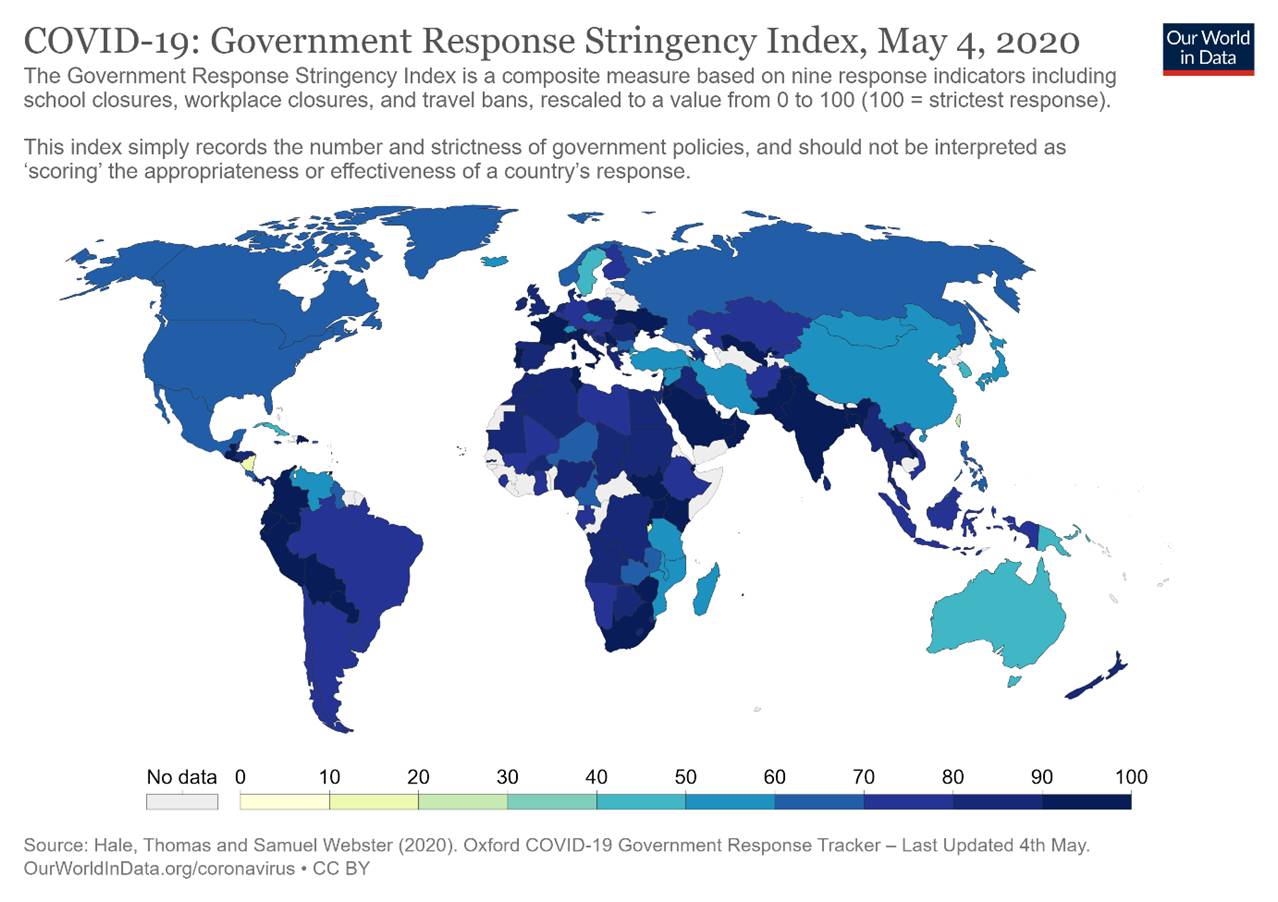
Chart-1: Government Response Stringency Index Map.
When will a National Lockdown and Containments End?
The Government Response Stringency Index Map, in the above-given Chart-1, places India on top at 97.35 along with its Asian neighbours few notches below, followed by Italy at 94.38, Spain at 89.41 and USA far below at 68.41 despite exponentially higher infection levels. It reflects India’s quick, strong and “pre-emptive” response that possibly prevented massive outbreak5 to levels comparable to the western nations, for which some credit must go to her containment strategy. South Korea was at 83.46 till mid Apr, 2020 before relaxing to 46.24.
But now the questions that emerge in all the infected nations are - When will NLDs be lifted for good? Are restrictions and social distancing the new normal? When will life return to complete normalcy? The likely answer to these commonly asked questions could be - as and when the world invents a cure or a vaccination, and after that, the nation develops the capacity to administer it at mass scale. An alternative timeline could be when an existing form of prophylactic treatment like the hydro-chloroquine6 or plasma therapy7 or an AYUSH treatment8, starts giving reliable and consistent results in community treatment at mass scale. A third alternative timeline for lifting the lockdown could be, when big data-based scientific analysis establishes beyond doubt that specific demographic population has an inherent immunity or has over time developed a high order of acquired immunity to coronavirus. We can realistically assume that any of these timelines are at least six months, if not one year, away. Then, what should be a nation’s strategic approach?
Aim. This paper attempts to suggest a strategic framework for any nation or state to transcend itself, with stability, from the current Coronavirus infected environment to a desirable end state of normalization into Post Coronavirus Immune World.
India's National Lockdown Mechanism is emerging as a stabilizing model9. Hence, this paper frequently refers to India as the case study but is not necessarily applicable to India alone. The paper has referred to data based case studies of USA, UK, Italy, France, Sweden, Czech Republic, Indonesia, Bangladesh and South Korea10. Former four, as nations which suffered the most and are now bending the curve, Sweden and the Czech Republic as examples of specific models as outliers in Europe, South Korea as a success story; and Indonesia and Bangladesh as neighbouring Asian nations.
Salient Components of Universal Counter Covid-19 Strategy Framework (UCCSF)
The proposed Universal Counter Covid-19 Strategy Framework comprise of six "Modes". Five of these are interlinked and overlapping, and when applied systematically, may facilitate a nation to transcend in a stable manner form current containment status to a desirable end state of normalcy in a Post Coronavirus Immune World. These Modes are:
- Self-Preservation Mode,
- Covid-19 Containment Mode,
- Economic Revival Mode,
- Herd Immunity Mode and,
- Normalisation Mode.
- The sixth mode called the Darwinian Mode which means "survival of the fittest", takes a dreadful path before reaching normalcy in a Post Coronavirus Unconceivable World.
Approach. The paper will briefly dwell on each mode and suggest how Universal Counter Covid-19 Strategy Framework (UCCSF) could be implemented or adopted, which has been explained with the help of a UCCSF Template as given at Figure 1. Subsequently, the paper attempts to reason why the UCCSF may be appropriate for India and may be enforced without significant upheavals. First, let us develop a concise understanding of each of the Modes.
- Self-Preservation Mode-Most stringent of all, this Mode aims to drastically eliminate secondary and community transmission to a level conducive for the adoption of Covid-19 Containment Mode and assiduously prevent inevitable imposition of "Darwinian Mode".
"Self-preservation"11 is defined as a behaviour or set of practices that ensure survival of an organism in the face of existential threat. In the context of Covid-19, humans are the organisms under threat. Should the infection outbreak multiply exponentially coupled with mass mortality, despite ongoing containment measures, a nation should consider switching to Self-preservation Mode at the individual, family, community, state and national level with differing criterion. The Mode's primary purpose is to preserve human lives and meet the survival needs of the human race. As per Maslow's Theory of Needs, apart from bottom two tiers of basic needs in the hierarchy of humans needs12 and other animal species the top three tiers of the pyramid are categorised into secondary and non-essential status. [Interestingly in the coronavirus infected world, the animal-human relationship has reversed. Animals are exceedingly and happily invading human space and joyfully witnessing encaged humans in natural habitat.] In this mode, the economic and governance activities are severely restricted, primarily aimed at delivering only existential needs of citizens. Lockdown and social distancing norms are stringent, even draconian by civilisational standards, and its enforcement is ruthless and unforgiving across the directed nation-state without exceptions. Wearing of "high-quality" face mask is made compulsory for all and violation a cognisable offence. Public institutions like schools and hotels converted to quarantine centres and treatment centres. Land, sea, air and space boundaries sealed for exit or entry.
Further, the government may consider nationalising all sovereign, public and private resources and surplus assets to meet the survival and preservation needs of every citizen. India's National Lockdown (NLD) Version 1.0 was somewhat on the brink of this mode but with a higher tolerance for lack of awareness and seriousness among people and helplessness of economically weaker sections. This could be the reason why certain Indian states and regions with low levels of infections earlier had transformed into clusters of outbreak. Imposition of Sec 144 of CrPC by Mumbai13, India is akin to the Mode.
- Covid-19 Containment Mode-This Mode aims at stabilising and then considerably lowering the infection rate and numbers to a level that would facilitate the adoption of a more relaxed and economically viable approach and prevent the imposition of the harsh Self-preservation Mode.
The current Mode under NLD 3.0 adopted by the Indian Government through MHA Order dated May 01 202014 and Ministry of Health and Family Welfare document dated April 28 2020, can be termed, in the parlance of this paper, as akin to Covid-19 Containment Mode. The country is demarcated into Red, Orange, Green and Containment Zones.15 Easing or tightening of economic and social activity levels are incentivised or penalised with a direct linkage to infection levels. Buffer zones of a nation would include neighbouring states. International travel is prohibited, and public transportation is severely restricted. Wearing a good mask and maintaining social distance in public and strengthening individual immunity must become a habit with individuals and implementation priority for Governments. The objective of this mode is to bring down the growth rate of infection to less than half when aggregated at the national level, and bring down several COVID cases to near zero at district and zonal levels thus contain infection to manageable levels of the nation's health infrastructure capacity. Economy is lesser priority. Manufacturing and supply of essential goods and services are permitted. Demand-Rationing16 is adopted for scarce goods. The success of this mode to a large extent is contingent upon a high level of awareness and cooperation of people and self - discipline of citizens coupled with strict implementation of social distancing norms through policing and other facilitation activities. The Indian state of Kerala, South Korea and Czech Republic Model make a good case study.17
- Economic Revival Mode-The Economic Revival Mode aims to revive the economy and drive the country towards long term self-reliance within a Coronavirus Infected World without destabilising the low infection levels. It provides for selective protected areas to commence full economic activity to drive a demand driven economy and prepare ground for transition to supply/investment driven growth in future.
As the name suggests, this mode has a more robust economic content alongside lifesaving purpose. Economic revival is attempted without destabilising infection levels achieved through Containment Mode. The country is demarcated into Infected Zones and Protected Economic Zones (PEZs). Infected Zones will adopt Self-preservation or Covid-19 Containment measures depending on levels of infection. Protected Economic Zones (PEZ) shall be created in the Green Zones. PEZs act as hubs of all economic, industrial and agricultural activities. In this Mode, economy is demand driven (not supply-side or investment driven) with self- reliance as primary motive. Other than luxury goods and services, all industries are allowed to operate freely in PEZs by observing minimal social distancing norms. New manufacturing units and IT Parks are created. These PEZs are guarded from coronavirus influx by deployment of stringent perimeter control. PEZs will feed the rest of the nation and also drive the economy to revival. Fiscal, monetary and economic policies promote unhindered functioning of PEZs. Social distancing norms are made less stringent. Social, welfare and political activities permitted with some restrictions.
- Herd Immunity Mode- This Mode aims to prepare the nation for the normalisation process into a post-Covid-19 world or even a Covid-19 prevalent world as the new normal prior invention of a cure or vaccination. Sweden has seemingly succeeded in adopting this model.18
This Mode is derived from a consistent universally emerging trend that youth population has low morbidity19-20 to coronavirus and the fact that infected individuals who have recovered completely would develop immunity through antibodies.21 This mode also factors the youth population's desire for freedom to work and socialise and their higher propensity for risk. Once infection level stabilises under Economic Revival Mode, the youth in other non-Green Zones are also permitted to take up work and socialise at individual levels without relenting from simple social distancing norms in public. However, children and adult below 20 years and population above 45 years of age are kept under home quarantine and segregated from working youth in non-Green Zones. Economic activity is also gradually scaled up in other non-Green Zones. Treatment and quarantine capacities scaled up for mass utilisation. Prophylactic treatment that has yielded relatively consistent positive results is administered at mass scale on exposed population. The ground is prepared to receive investments from FIIs. Corporations, including foreign, are encouraged to set up and scale up manufacturing and create a new industry. Investment driven22 supply-side economics23 is encouraged.
- Normalisation Mode. Assuming that a nation successfully contains Covid-19 without mass loss of human life, and administration of immunisation/cure has begun, the Normalisation Mode will lead the country into a post coronavirus free world. The features of the mode would depend on which of the two is first ready for administration. The mode would have to articulate equitable distribution of growth, relocation of displaced migrants, job creation, economic revival and impetus, rebuilding damaged assets, creating new commercial corridors and preventing a second wave, like in case of Spanish Flu. 24 Governments would need to evolve holistic policies to overcome issues both societal and infrastructural that lie exposed and vulnerable. Post coronavirus scenario remains highly unpredictable at this stage with each nation having her unique vision for itself. Hence, this mode is not being dealt with in this paper. However, in case the vaccine or cure is found to be unstable, one may have to revert to Herd Immunity Mode or Economic Revival Mode depending on which Mode the nation transcended from. A nation, depending on its size, immunisation capacity and economic position may have to stay in Normalisation Mode for over a year.
- Darwinian Mode- would be the last resort with any Govt should Self Preservation Mode also fail to contain mass uncontrolled exponential outbreak of infection and the Govt runs out of resources and means to sustain the Nation in Self Preservation Mode for prolonged duration. This mode has an inevitable outcome with the end state of normalisation in an unpredictable Post Coronavirus Inconceivable World. It is opposite of Self-preservation Mode. It is based on Darwin's theory of survival of the fittest. 25 The imposition of Darwinian Mode may become inevitable, under two scenarios. First, if Self-preservation and Containment Mode are a complete failures and situation becomes characterised by massive uncontrolled outbreak of coronavirus infections and widespread unrest against severity of extended lockdowns; with cure/vaccination being nowhere in sight. Also, beyond a point, under the Self-preservation Mode, the government may exhaust its economic resources to sustain the population under lockdown conditions over an extended period. In such an extreme unlikely eventuality, lockdowns may be consciously and progressively eased, and people allowed to step out and work unhindered. COVID is faced aggressively (not defensively as in other Modes) with all available means of treatment and immunity measures at the disposal of the nation. At the end of it, the biologically immune and resilient survive. Over many cycles of infections, the population develops herd immunity to coronavirus and situation eventually stabilises, albeit after the loss of numerable human lives. The nation is rebuilt like Spain was after Spanish Flu. The end state would be a new nation in an unpredictable and unknown Post Coronavirus World.
A second unlikely scenario, termed as Darwinian Scenario is worse and dreadful, resulting from loss of governance, in addition to a massive outbreak of coronavirus and possible upheaval against hunger and lockdown severity, thus leading to impairment of government writ. Consequently, a nation may slip into civil unrest followed by dreadful prolonged cycles of the pandemic strike and civil unrest into an unknown, unpredictable inconceivable future. Hence, even the remotest possibility of slipping into Darwinian Mode or Darwinian Scenarios is to be ruthlessly prevented with all means at the disposal of a nation.
Applicability of the UCCSF
These proposed Modes can be applied universally, duly adjusted for regional peculiarities. Nations can apply it to regions within a country, provinces or states, or at even districts levels by incorporating locally relevant modifications. For, instance, the situation in Vietnam and South Korea, and the Indian state of Kerala, may be conducive for the adoption of Economic Revival Mode. Other regions of India like North-East states, Goa, Uttarakhand, Himachal Pradesh, which have seen negligible infection levels, too can consider this option, provided prior to that, extensive testing drive is to be undertaken to create scientific adequate evidence that no significant influx of virus has taken place in the region. States which have high levels of confirmed cases, but very low rates of morbidity and mortality due to Covid-19 can consider adopting Herd Immunity Mode provided they have the necessary health infrastructure to handle any unexpected increase in morbidity. Indian States like Gujarat, Delhi, and Maharashtra may have to consider switching to Self-preservation Mode should the Covid-19 infection rate start doubling from the datum. Nations like Italy and Spain have returned from the brink of Darwinian Scenario without having to adopt Self Preservation Mode owing low population density and very high per capita availability of healthcare services, albeit, after bearing the brunt of massive loss of life.
Applying the UCCSF Template
Adoption of UCCSF Cycle is a function of infection levels, population density, population immunity, and healthcare infrastructure capacity. The UCCSF Template in figure 1 explains relationship between the Modes and how and when a nation or region can or should transcend from one mode to another or reverse switch.
Counter Covid-19 Effectiveness Level Indicator Suggested for UCCSF Template
A plethora of indicators is now making rounds in the World Wide Web through research papers and significant data analysis reports. These indicators have differing scope and varying interpretations and are subject to some level of inconsistencies26, especially concerning testing rates and testing mechanisms. Broadly the paper suggests the use of three Rates.
First, Confirmed Covid-19 Rate (CCR) (Chart 2), defined as cumulative numbers of confirmed cases of Covid-19 patients per million and the rate at which it is changing.
Second, Case Fatality Rate (CFR) (Chart 3) defined as the ratio between the cumulative numbers of Covid-19 related deaths and cumulative confirmed cases of Covid-19.
Third, Covid-19 Recovery Rate (CRR) which is the ratio between a cumulative number of recovered cases and cumulative confirmed cases of Covid-19.
Notwithstanding the dependency of CCR on testing rates, together these three indicators can provide a fair and realistic assessment of Covid-19 spread, and "sum total" of the effectiveness of containment measures taken by a Nation, State or Region, the capacity cum capability of healthcare infrastructure and inherent/acquired immunity of the population demography. For example, if CCR is very low below the world average, but CFR is very high, then it would imply low testing rates. However, if both are low, then it means a low level of infection and high inherent resilience of the population. Likewise, if CCR and CCR are high, it implies a high resistance of the population to Covid-19. Consistent reduction trend in both CCR and CFR is a positive sign of success of the Mode.
Likewise, consistent increasing trend in both CCR and CFR and a reduction in CRR indicate ineffectiveness of a Mode and may dictate switching to a more stringent Mode. Reduction in CCR but increase in CFR may mean the failure of healthcare systems and other mixed outcomes. It would necessitate analysis against other indicators like testing rates, recovery rates, etc, before drawing reliable inferences. However, an increase in and CCR and CRR but the decrease in CFR may indicate a reduction in the effectiveness of containment measures but improvements in the efficiency of the healthcare system and/or acquired immunity of population. Thus, before taking any major decision on switching modes, the outcome needs to be verified and validated through the analysis of other many relevant indicators.
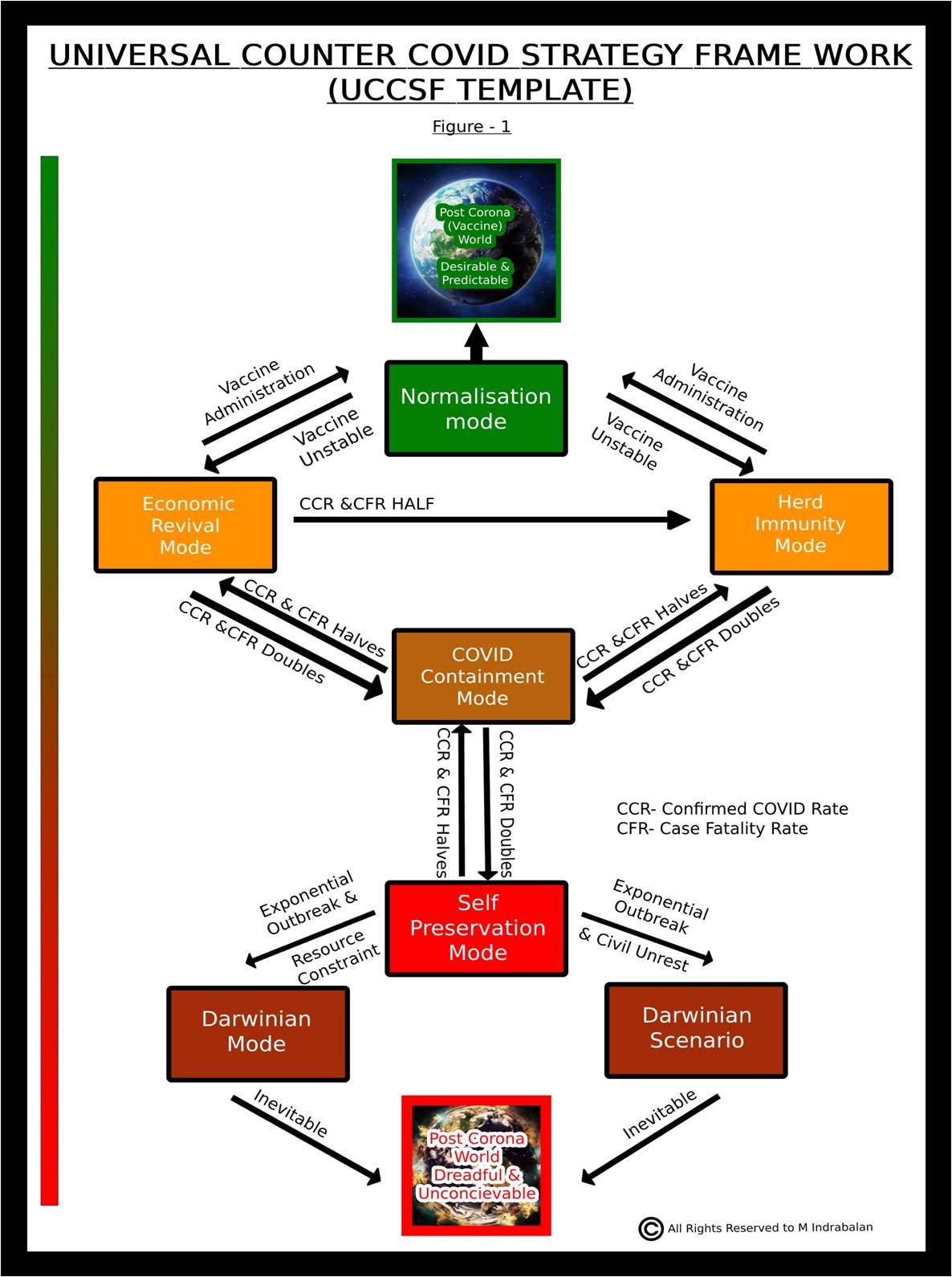

Chart 2: Confirmed Covid-19 Rate (CCR).

Chart 3: Case Fatality Rate (CFR)
Charts 2 & 3 indicates that India has comparatively very low levels of infection per million. Even though India's testing rates is low compared to European Nations, her low CFR negates the worry on low testing levels. India’s very low CFR per million and high CRR per may also be indicative of higher resilience of the population, though it may be bit too early to rely on it. USA having high CCR but low CFR implies low effectiveness of containment strategy but high efficacy of health care system. The Czech Republic demonstrates high effectiveness of containment strategy and its healthcare system. Incidentally, Czech Republic was the first to introduce "Mask for Masses" strategy and the reason why it is an outlier in Europe in CCR. Indonesia has low levels of infection (CCR) but very high CFR implying low testing rates and also insufficient health support systems.
UCCSF Decision Matrix
To start with, Nation X or a state or a region may fix the "Datum Date of Covid-19 Spread (DDCS)", which could ideally be 40days post the first confirmed Covid-19 Infection. This is based on finding by former Israeli Air Force retired Major General Yitzakh Ben-Israel. As per him, coronavirus spread peaks27 after 40 days or six weeks and declines to almost zero after 70 days. The UCCSF templates is best applied around this time period since the collected data gives a fair and reliable estimate of virus spread after factoring the sum total of all other independent variables like the containment stringency and its effectiveness, capability of health care services, inherent resilience and acquired immunity of the population. A nation or region can for itself figure out which UCCSF Mode it was on, on the chosen DDCS by comparing the modalities of its containment strategy with the UCCSF Modes described above.
Assume that on chosen DDCS a Nation X or region is administering something akin Covid-19 Containment Mode. If both CCR and CFR tend to approach half in 30 days from DDCS, then Nation X can plan to transcend to Economic Revival Mode. In case of a dramatic reduction in both CCR and CFR, to say one third in the same period, then Nation X can even directly consider transcending to Herd Immunity Mode especially if CRR among youth population is very high. Nation X also has the option to remain longer on Economic Revival Mode to await the introduction of cure/vaccination and then move to Normalisation Mode directly. Alternately, should there be a substantial (one fourth) reduction in CCR and CFR during Economic Revival Mode, but cure/vaccination not in sight, she can transcend to Herd Immunity Mode and stay there longer.
On the contrary, during Covid-19 Containment Mode should CCR and CFR both increase dramatically (double), then Nation X should consider switching to Self-preservation Mode. Once Self Preservation Mode succeeds in lowering both CCR and CFR to half, then Nation X can transcend back to Covid-19 Containment Mode, and so on. In case of a continued increase in both CCR and CFR after 30 days in Self Preservation Mode, further increase in spread should be ruthlessly curbed, lest the state slips into Darwinian Scenario. In such an extreme unlikely eventuality it may be advisable to adopt Darwinian Mode consciously rather than letting Darwinian Scenario prevail.
Why Does India Need to Adopt UCCSF Model?
World Covid-19 Spread Predictions: Predictive Monitoring of Covid-19, by SUTD Data Driven Innovation Lab28, Singapore, forecasts end of coronavirus by early to mid Jul, 2020 for majority of developed European Nations and USA. The same predictive charts, show that the Asian nations like India and Indonesia substantially deviating from peaking dates and ending dates for Covid-19 from what was predicted by STUD analytics as end May and end Jul, 2020 respectively. More concerning is the fact that India, Indonesia, Brazil, Mexico, UAE and Singapore are also exhibiting very high 5-day average volatility (standard deviation between 30 and 20) as compared to developed European nations which are exhibiting low volatility (standard deviations between 6 and 1 only) implying that the real spread and future forecasts for developing countries remains highly unpredictable. As per the author’s analysis of case studies and patterns of plethora of countries now available in research reports, for period beyond 100 days also, it emerges that the 40 day peaking logic given by Israeli Air Force retired Major General Yitzakh Ben-Israel, may apply to relatively small or less populated countries like Israel, Czech Republic, Vietnam, which house uniform demography of population and where containment measures are homogeneously applied and adhered to dutifully by nearly 100 percent of the population. In such countries, the virus does not find a new host beyond a point in time and eventually gets impaired. But in nations like India and other developing countries that are housing large, dense and diverse mix of population demography, extreme range of nutritional levels, immunity levels, economic conditions, practices, habits, and some economically deprived sections facing bigger existential threat than coronavirus itself coupled with mixed response to containment measures by people; a peak or a bending of curve may not be found so early. This is because, the virus may always have a new set of host community to spread and mutate in large numbers.
There is now an implicit acceptance in India that "social distancing lifestyle" may be the new normal. The only hope World and India had of the high temperature of summer season eliminating the virus has now been dispelled. The next "hope line" is the invention of cure and/or vaccination. An alternate hope line could be early development of herd immunity. The realisation of any of these is at least six to eight months away. In fact, the United States is predicting it might take up to twenty months to develop a vaccine.29 Further, introduction of these for mass scale administration may take many more months. Assume, as a best-case scenario, a vaccine is successfully developed in India itself by September 202030 and its availability for mass administration by December 2020.
In the past few weeks India's CFR (death rate) was doubling every 8 to 9 days as on May 07, 2020, whereas, in most Europe and America the curve is tending to flatten, as per chart No. 6. The case presently in India's favour is that its per million infection level and daily new cases level are on an average 2000 times lower than USA and European countries. Also, India’s mortality rate per million is on an average 3000 times lower. Further, her doubling rate of CFR is much lower than her CCR. These factors currently place India on a relatively safer level on absolute number scale.
However, what goes against India is her CCR, growth rate of infection, which is currently doubling every 5 to 6 days as on May 11, 2020, See Chart 4. Most European Counties and USA which were doubling every two days in early April 2020 have nearly flattened the curve by May, 2020, albeit at much higher total infection levels and loss of thousands of lives. Secondly, even though India's per million CCR and total CCR is only a small fraction of that of European Nations, but on a non-log scale India is still on the upwardly steep exponential curve since April 08, 2020, well after imposition of NLD 1.0 and NLD 2.0, See Chart 5. Therefore, with India’s current CCR doubling rate of 5 to 6 days, in next 30 days from May 11, 2020 (when CCR is 38.37 per million), it's total confirmed Covid-19 cases may reach 1,596,192 that too without factoring low test rates. Likewise, her CFR is currently doubling every 7 to 8 days. So, in the next 30 days, starting from May 11, 2020 (when CFR was 1.29 per million), its total deaths due to Covid-19 may reach 26,832. By USA or European levels, these figures may not be alarming. Also, if only last 3-days rolling average of these indicators are taken then the doubling rates reduce to 12.6 days for CCR and 13 for CFR, a favourable trend, provided it lasts.
But imagine hypothetically, that owing to the mass migration of labourers and Covid-19 outbreaks in slums and densely populated areas coupled with relaxed adherence to social distancing and containment norms by people, the CCR starts doubling every four days. In such an eventuality, in the next 30 days, the total Covid-19 cases could reach 12,768,532. At this rate, the total infections by the end of six months or before mass administration of vaccination may run into millions31. As per a paper based on mathematical modelling published in Medical Journal of Armed Forces, on Mar 30, 2020, at current growth rate of epidemic, India’s health care resources will be overwhelmed32 by the end of May, 2020, (See Charts 7&8). A proportionate increase in total deaths would be inconceivably unbearable for the nation.
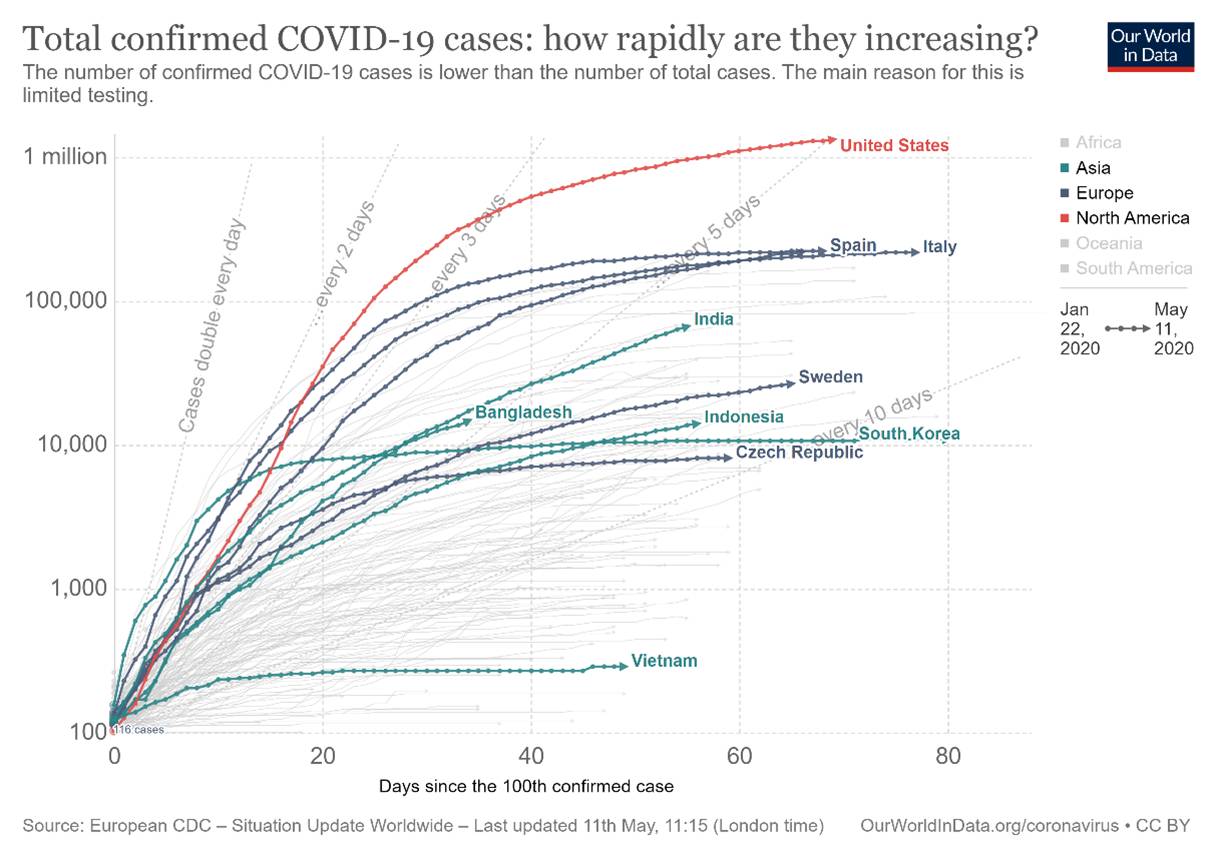
Chart 4: India's CCR growth rate of infection currently doubling every 5 to 6 days.

Chart 5: India is on the upward steep exponential curve since April 08, well after NLD 1.0.
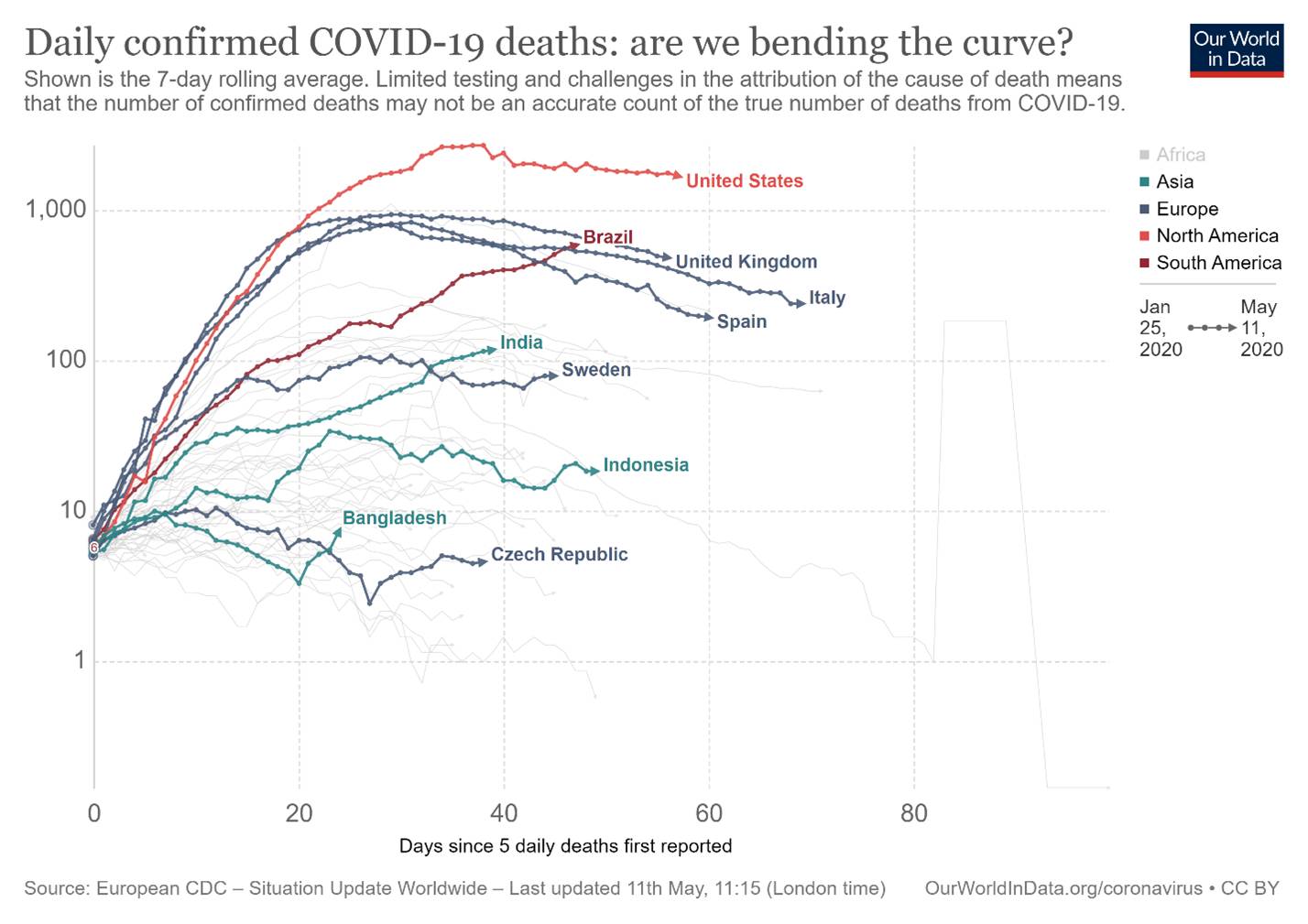
It is well known that there is direct correlation between gross mass infections in India and rate of community transmissions with the speed of mass cure and the pace of large-scale immunisation programme which in turn would prescribe the total effort required and length of the recovery period. Of these four variables, only two variables are somewhat in the Nation's control today. That is minimising secondary transmissions and containing community transmissions through stringent lockdowns and social distancing norms, which India must enforce ruthlessly. It is here that UCCSF may offer a rough template for transition into different stringency Modes relative to growth or reduction in Covid-19 infection levels.
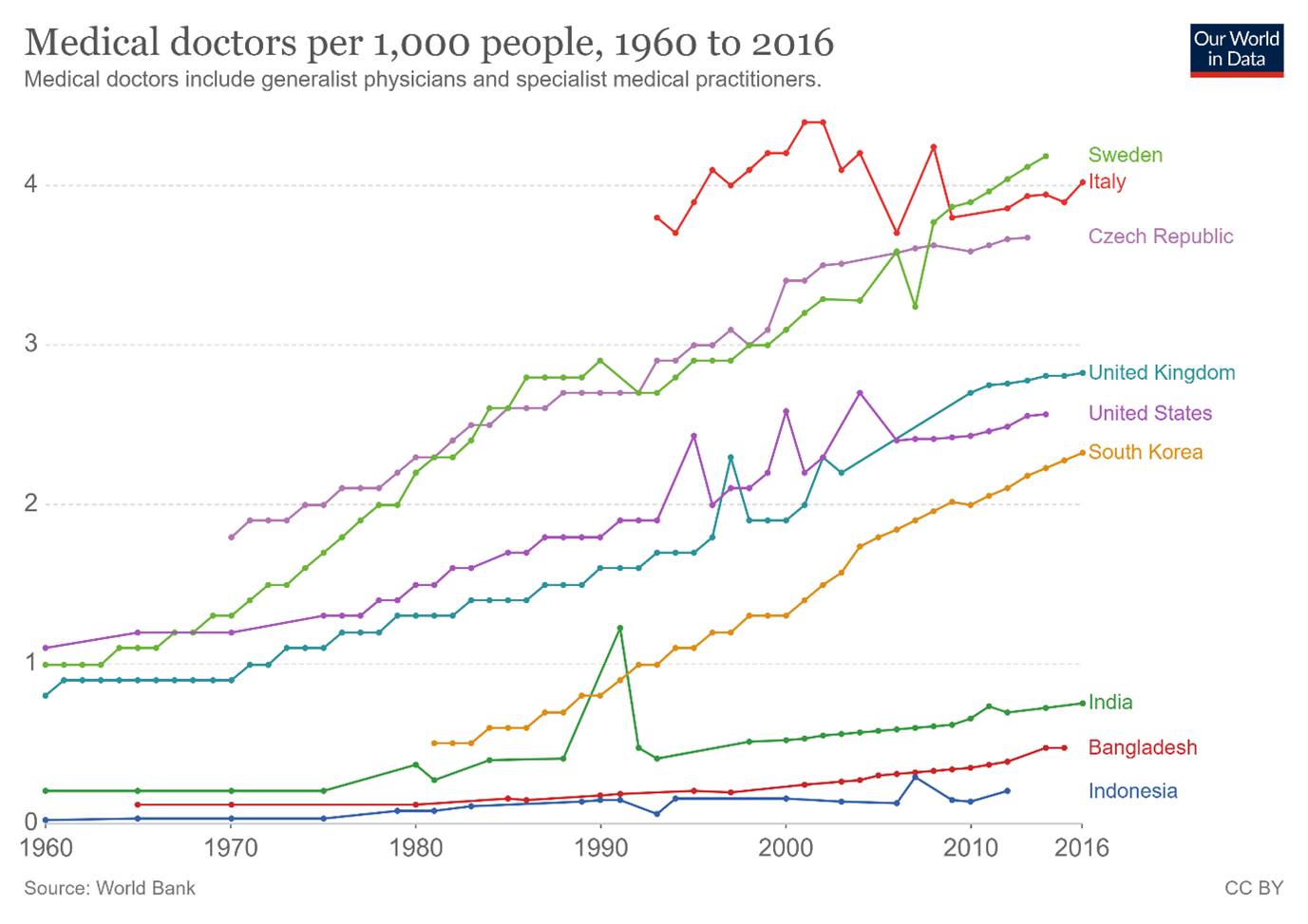
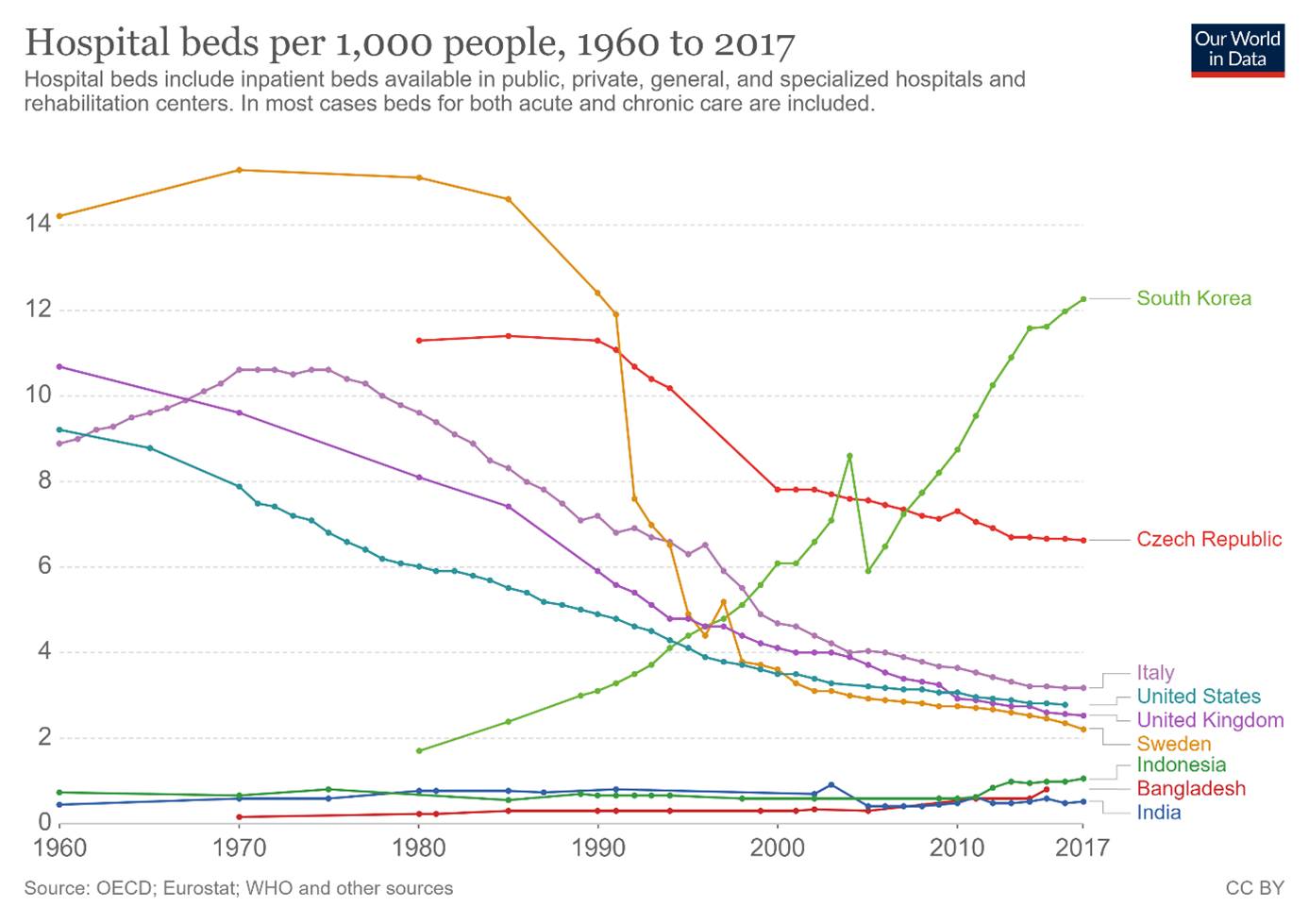
Is it feasible for India to Adopt UCCSF Template?
India can well capitalise on the advantages that have accrued out of stringent pre-emptive national lockdown and numerous other medical and healthcare control measures adopted by the Government of India. Rapid ramping up of quarantine facilities, healthcare infrastructure and pooling of medical resources through innovative and legislative means should be a priority for India. Many demographic, social, cultural and healthy practices, favour India's capacity and propensity to implement UCCSF for a prolonged duration. India fortunately, has a steeper learning curve in medically dealing with the pandemic, owing to highly acclaimed medical fraternity as well as the availability of precedents of other countries to learn from their experiences. Unlike western nations and developed countries, majority of the Indian society and population has the ability and proclivity to live under meagre living conditions, low subsistence and minimal levels of social interaction. She, however, also houses nearly the highest density and total population of the World, a large percentage of which are inhabiting in highly dense population concentrations of migrant labourers, slums and economically weaker sections with meagre on no means for satisfactory healthcare services. Hence, massive outbreak among this section of the community will be unmanageably nightmarish for the nation. Hence, providing for healthcare and subsistence needs of this section must be a priority for the nation and an integral part of UCCSF. Direct Benefit Transfer to economically weaker sections, food supply and running of community kitchens by NGOs, decent shelter camps and quarantine for migrant labours, retention of blue-collar workers, are all measures for soothing the severity of lockdowns. Understandably, all this will be at an enormous economic cost. To cater for which, if need be, resources in the country should be pooled to minimise the severity and harshness of lockdown on the poor and hapless. If need be, the government must not be reluctant to nationalise the billions of currencies stashed abroad in 'benami and nami' accounts of Swiss bank and other safe havens. Further, a portion of substantial monetary reserves held by our giant public and private limited companies could be nationalised like it was done to the Indian private banks in 1969 and 1980.33
This is not the time to worry about fiscal deficits, GDP growth rate or Moody's ratings. Drastic measures called for during extreme times. The government need not feel defensive about it. If India succeeds in containing the COVID at present levels, even at the cost of massive economic downturn, she stands a fair chance of emerging economically stable and reliable, once a vaccine or cure is introduced. Our frugal living styles, demand-driven instead of investment driven economy and strong agricultural base can make us a self-sustaining nation during this period of the pandemic strike. Once the pandemic passes away and if India maintains its outlier status, financial capital and the manufacturing industry-beating a hasty retreat from China and other parts of the world will make a beeline for India and other Asian nations. India has the necessary, intellectual capital, skill capital, labour capital, IT capital, and land capital as also the market size to attract huge investments from FIIs and multinational corporations. She will then be in the sweet spot of economic revival and may well become a rising economic powerhouse.
Suggested Way Forward
The UCCSF helps in advance brainstorming, planning and preparation for steering the future course, and adoption of or transitions into any of the Modes. Likewise, any nation, immaterial of its current level of spread and containment strategy, can use the template and create its future course by positioning itself appropriately in the UCCSF Cycle. For India, as on May 07, 2020, the CFR per million was 1.29 and CCR was 34.37, which is a tiny fraction when compared to the rates of European Nations and the USA. So far, India has exhibited good resilience to COVID-19, which is a reflection of as a total of the effectiveness of her containment strategy, healthcare services and natural immunity of people. However, current trends suggest that India is yet to hit the peak before it starts flattening. As per AIIMS infection in India is likely to peak only between June-July 2020.34 Other estimates place it around September 20. Also, even though Italy and UK are claiming break though in vaccine discovery as per Harvard Business Review it would take six months35 or more for it to reach common masses. India can ill afford exponential growth of COVID for such a prolonged period, even a few days reduction in doubling rate can take the total infection to millions and beyond her capacity to sustain.
It implies that India would have to continue its containment strategy until then. With unpredictability levels of COVID growth still very high and likely prolonged wait before the arrival of vaccine there is a need to adopt appropriate modes to ensure a smooth and stable transition into a post coronavirus world. The UCCSF discussed in this paper would make a good template for India as a whole or any of her states to draw from and formulate her plan to deal with the pandemic in a long term scenario of pre-vaccine coronavirus infected world. The success or failure of any Mode or the entire UCCSF cycle will be contingent upon cooperation, willingness and the innate desire of the population to emerge victorious in COVID battle with minimal mortality.
Till then wearing a good face mask and maintaining social distance in public and strengthening individual immunity must become a habit with individuals and implementation priority for Governments.
Endnotes
- “India will be under complete lockdown for 21 days: Narendra Modi”,Economic Times, March 25,2020, https://economictimes.indiatimes.com/news/politics-and-nation/india-will-be-under-complete-lockdown-starting-midnight-narendra-modi/articleshow/74796908.cms?from=mdr
- Ministry of Home Affairs, Order No. 40-3/2020- DM-I (A), Government of India, April 14, 2020, https://www.mha.gov.in/sites/default/files/MHA%20DO%20letter%20dt
- ‘Coronavirus lockdown till May , areas with no hotspots to get conditional relief from April 20: PM Modi’, India Today, April 20,2020, https://www.indiatoday.in/india/story/pm-narendra-modi-announcement-date-and-time-lockdown-2-coronavirus-covid19-1666685-2020-04-14.
- Ministry of Home Affairs, Order No. 40-3/2020- DM-I (A), Government of India, May 1, 2020, https://www.mha.gov.in/sites/default/files/MHA%20Order%20Dt
- https://theprint.in/opinion/covid-19-lockdown-successful-or-not-there-are-5-ways-to-answer-this-question/415049/
- Ministry of Health and Family Welfare, ‘Advisory on the use of hydroxy-chloroquine as prophylaxis for SARS-CoV-2infection’March 22,2020,https://www.mohfw.gov.in/pdf/AdvisoryontheuseofHydroxychloroquinasprophylaxisforSARSCoV2infection.pdf
- ‘Kerala to start clinical trials of convalescent plasma therapy for COVID-19 treatment’, COVID India.org, https://covidindia.org/treatment/
- ‘Gujrat government to try Ayurvedic drugs on select COVID-19 patients’,Business Insider, April 27,2020, https://www.businessinsider.in/india/news/guj-govt-to-try-ayurvedic-drugs-on-select-covid-19-patients/articleshow/75408415.cms
- Rukmini S, ‘Covid-19 lockdown, successful or not? There are 5 ways to answer this questions’, https://theprint.in/opinion/covid-19-lockdown-successful-or-not-there-are-5-ways-to-answer-this-question/415049/.(Accessed May 6, 2020).
- ‘Research and data to make progress against the world’s largest problems’, Our World in Data, https://ourworldindata.org/
- ‘Self-preservation - definition of self-preservation’,The Free Dictionary, TheFreeDictionary.com.
- Saul McLeod, ‘Maslow’s Hierarchy of Needs’,Simply Psychology, March 20,2020 https://www.simplypsychology.org/maslow.html
- Mateen Hussain, ‘Section 144 in Mumbai from 8 pm to 7 am Till May 17’ Times of India https://timesofindia.indiatimes.com/city/mumbai/section-144-in-mumbai-from-8pm-to-7am-till-may-17/articleshow/75543780.cms (Accessed May 6, 2020).
- Ministry of Home Affairs, Order No. 40-3/2020- DM-I (A), Government of India, May 1, 2020, https://www.mha.gov.in/sites/default/files/MHA%20Order
- Shweta Sengar, ‘Where are Coronavirus Containment and Hotspot Zones in India? Check if you are Residing in One’, India times, April 09, 2020, https://www.indiatimes.com/trending/human-interest/full-list-india-containment-zones-after-lockdown-512251.html
- Prehn, Sören, Glauben, Thomas and Loy, Jens-Peter. ‘Demand-Driven Markets and the Importance of Demand Rationing’, B1-109-Prehn-Demand_Driven_Markets_and_the_Importance_of_Demand_Rationing - PDF (Accessed May 8, 2020).
- Niha Masih, ‘Aggressive testing, contact tracing, cooked meals: How the Indian state of Kerala flattened its coronavirus curves’, April 14, 2020, https://www.washingtonpost.com/world/aggressive-testing-contact-tracing-cooked-meals-how-the-indian-state-of-kerala-flattened-its-coronavirus-curve/2020/04/10/3352e470-783e-11ea-a311-adb1344719a9_story.html
- Chitranjan Kumar, ‘Sweden: The world champion of ‘herd immunity’ in fight against coronavirus’, Business Today, April 22,2020,https://www.businesstoday.in/current/world/sweden-the-world-champion-of-herd-immunity-in-fight-against-coronavirus/story/401751.html
- ‘Case fatality rate of COVID-19 vs. Median Age’,
Our World in Data, May 7, 2020, https://ourworldindata.org/grapher/case-fatality-rate-of-covid-19-vs-median-age - ‘Coronavirus death rate in Italy as of May 4,2020, by age group’, Statista Research Department, May 4, 2020https://www.statista.com/statistics/1106372/coronavirus-death-rate-by-age-group-italy/
- Scientific Brief, “Immunity passports” in the context of COVID-19’,World Health Organisation (WHO),April 24,2020, https://www.who.int/news-room/commentaries/detail/immunity-passports-in-the-context-of-covid-19
- Ashima Goyal, ‘How to revive the economy post lockdown’, The Business Line, https://www.thehindubusinessline.com/opinion/columns/ashima-goyal/how-to-revive-the-economy-post-lockdown/article31495154.ece (Accessed May 4, 2020).
- Viktor Jakupec, ‘Aid for Trade: Critical Analysis’, Supply Side of Economics, https://www.sciencedirect.com/topics/social-sciences/supply-side-economics (Accessed 6 May, 2020).
- Milorad Radusin, ‘The Spanish Flu – Part II: the second and third wave’, VOJNOSANITETSKI PREGLED 2012; 69(10): 917–927, https://www.rastko.rs/cms/files/books/5218e8f259be8
- Mapmygenome, ‘Charles Darwin- Survival of the Fittest’, February 12, 2016, https://mapmygenome.in/blog/charles-darwins-survival-of-the-fittest/
- ‘Research and data to make progress against the world’s largest problems’, Our World in Data, https://ourworldindata.org/
- Stephen Bryen, ‘Israeli Professor offers alternate coronavirus prediction’, Asian Times, https://asiatimes.com/2020/04/israeli-professor-offers-alternate-coronavirus-prediction/ (Accessed May 6, 2020).
- Data Driven Innovation Lab, ‘Predictive Monitoring of Covid -19 by SUTD Data Driven Innovation Lab’, Singapore.https://ddi.sutd.edu.sg/ (Accessed May 11, 2020).
- Shawn Radcliffe, ‘How Long Will it Take to Develop a Vaccine for Coronavirus?’, Healthline, January 30, 2020,https://www.healthline.com/health-news/how-long-will-it-take-to-develop-vaccine-for-coronavirus#Faster-vaccine-development
- Ankita Bhandari, ‘Pune’s Serum Institute to start making coronavirus vaccine that is under trial’, Zeenews, April 27,2020, https://zeenews.india.com/india/punes-serum-institute-to-start-making-coronavirus-vaccine-that-is-under-trial-2279425.html
- Kaustuv Chatterjee, Kaushik Chatterjee, Arun Kumar and Subramaniam Shankar, ‘Health Care Impact of Covid -19 epidemic in India: A scholastic mathematical Model’, Medical Journal Armed Forces India, https://www.ncbi.nlm.nih.gov/pmc/articles/PMC7126697/ (Accessed May 1, 2020)
- ibid
- Samar Srivastava, ‘Economic Milestone: Nationalisation of Banks’, Forbes India, August 12, 2014, https://www.forbesindia.com/article/independence-day-special/economic-milestone-nationalisation-of-banks-(1969)/38415/1
- Coronavirus AIIMS director says cases likely to hit peak in June-July’, The Hindu, May 7,2020, https://www.thehindu.com/news/national/coronavirus-aiims-director-says-cases-likely-to-hit-peak-in-june-july/article31529932.ece
- Rebecca Weintraub, Prashant Yadav and Seth Berkley, ‘A COVID-19 Vaccine Will Need Equitable’, Global Distribution, April 02, 2020, https://hbr.org/2020/04/a-covid-19-vaccine-will-need-equitable-global-distribution
(The paper is the author’s individual scholastic articulation. The author certifies that the article/paper is original in content, unpublished and it has not been submitted for publication/web upload elsewhere, and that the facts and figures quoted are duly referenced, as needed, and are believed to be correct). (The paper does not necessarily represent the organisational stance... More >>











Post new comment